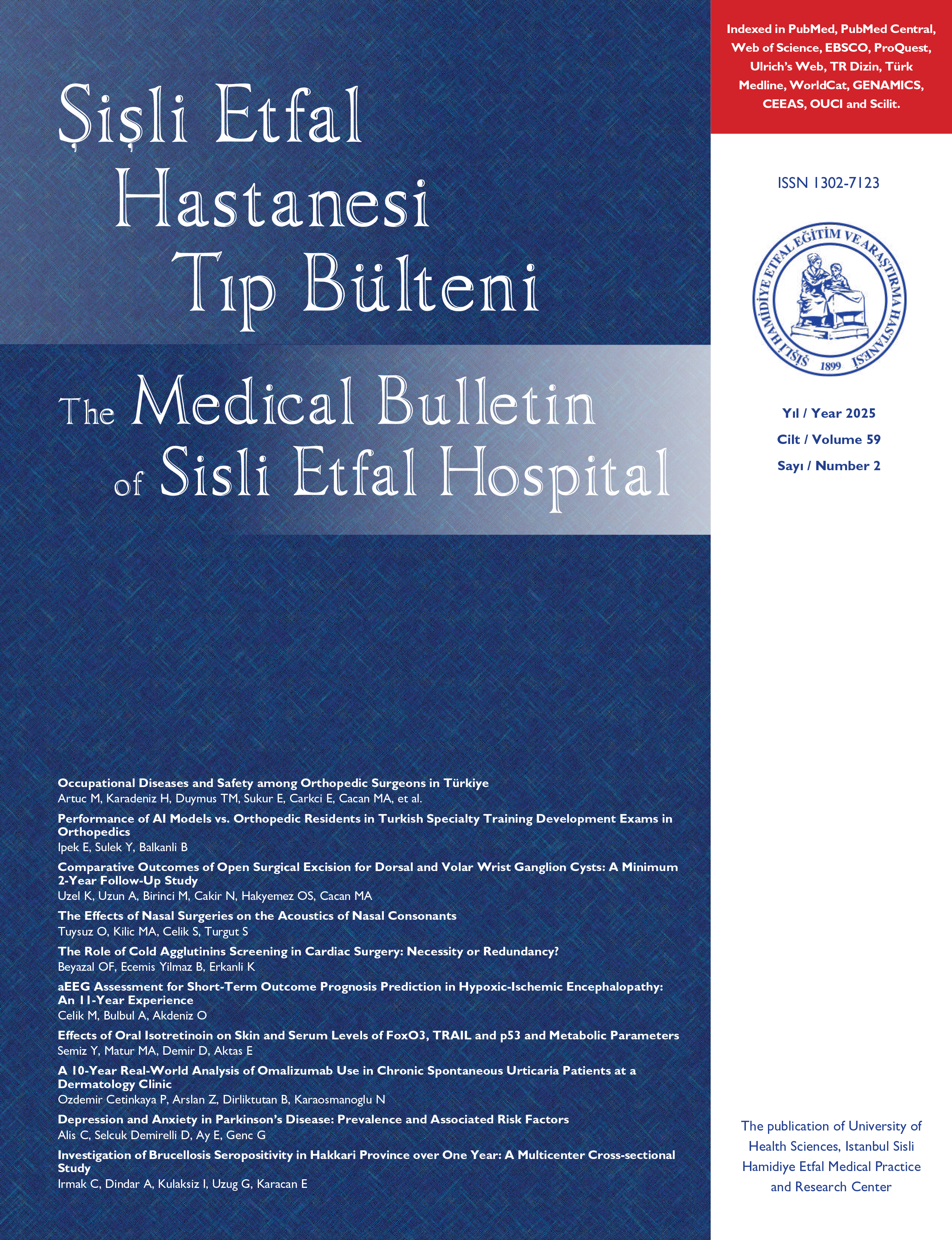
Benign paroksismal pozisyonel vertigoda oksidatif stresin rolünün spot idrarla araştırılması
Ozan Ozdemir1, Hale Aral2, Halit Ruzgar1, Hilmi Furkan Arslan3, Ozgur Yigit11Türkiye Sağlık Bilimleri Üniversitesi İstanbul Eğitim ve Araştırma Hastanesi, Kulak Burun Boğaz/Baş ve Boyun Cerrahisi Kliniği, İstanbul2Türkiye Sağlık Bilimleri Üniversitesi İstanbul Eğitim ve Araştırma Hastanesi, Tıbbi Biyokimya Anabilim Dalı, İstanbul
3Giresun Üniversitesi, Kadın Doğum ve Çocuk Hastalıkları Eğitim ve Araştırma Hastanesi, Tıbbi Biyokimya Anabilim Dalı, Giresun
Amaç: İdrarda 8-hidroksi-2'-deoksiguanozin (8-OHdG), 8-hidroksi-guanozin (8-OHG) ve 8-hidroksi-guanin seviyeleri ölçülerek oksidatif stresin benign paroksismal pozisyonel vertigodaki (BPPV) rolünü değerlendirmek.
Yöntem: Bu çalışmaya BPPV tanısı almış 31 yetişkin kadın hasta dahil edildi. Santral ve diğer periferik vertigo nedenleri saptanan hastalar çalışma dışı bırakıldı. Hastalar BPPV atağı sırasında ve sonrasında kan örnekleri ve spot idrar testleri ile oksidatif stres açısından değerlendirildi. Duygusal stresi değerlendirmek için Depresyon, Anksiyete ve Stres Ölçeği (DASS) anketi kullanıldı. Yaşları eşleştirilmiş 30 sağlıklı kadından oluşan kontrol grubu oluşturuldu.
Bulgular: Atak sırasındaki üriner oksidatif stres değerleri, tedavi sonrası gruba ve sağlıklı kontrol grubuna göre anlamlı olarak yüksekti (p<0.05). Tedavi sonrası BPPV grubunun üriner oksidatif stres değerleri ile sağlıklı kontrol grubu arasında anlamlı fark yoktu (p>0.05). DASS skorları atak sırasında ve tedavi sonrasında sağlıklı kontrol grubuna göre anlamlı olarak yüksekti (p<0.05).
Sonuç: BPPV hastalarında spot idrar 8-OHdG, 8-OHG ve 8-hidroksi-guanin düzeylerindeki artış oksidatif stres için bir biyobelirteç olarak kullanılabilir. Ayrıca emosyonel stres oksidatif stresi artırarak BPPV ataklarını da tetikleyebilir. (SETB-2022-12-268)
Investigating the Role of Oxidative Stress in Benign Paroxysmal Positional Vertigo with Spot Urine
Ozan Ozdemir1, Hale Aral2, Halit Ruzgar1, Hilmi Furkan Arslan3, Ozgur Yigit11Department of Otorhinolaryngology/Head and Neck Surgery, University of Health Sciences Türkiye, Istanbul Training and Research Hospital, Istanbul, Türkiye2Department of Medical Biochemistry, University of Health Sciences Türkiye, Istanbul Training and Research Hospital, Istanbul, Türkiye
3Department of Medical Biochemistry, Giresun University, Maternity and Children Training and Research Hospital, Giresun, Türkiye
Objectives: The objectives of this study were to evaluate the role of oxidative stress in benign paroxysmal positional vertigo (BPPV) by measuring urinary 8-hydroxy-2'-deoxyguanosine (8-OHdG), 8-hydroxy-guanosine (8-OHG), and 8-hydroxy-guanine levels.
Methods: Thirty-one adult female patients diagnosed with BPPV were included in this study. Patients with central pathologies and other peripheral causes of vertigo were excluded from the study. The patients were evaluated for oxidative stress during and after the BPPV attack with blood samples and spot urine tests. Depression, anxiety, and stress scale (DASS) questionnaire was used to evaluate emotional stress. A control group consisting of 30 age-matched healthy women was formed.
Results: Urinary oxidative stress values during the attack were significantly higher than the post-treatment group and the healthy control group (p<0.05). There was no significant difference between the urinary oxidative stress values of the BPPV group after treatment and the healthy control group (p>0.05). DASS scores were significantly higher during the attack and after the treatment compared to the healthy control group (p<0.05).
Conclusion: The increase in spot urinary 8-OHdG, 8-OHG, and 8-hydroxy-guanine levels can be used as a biomarker for oxidative stress in patients with BPPV. Furthermore, emotional stress can also trigger BPPV attacks by increasing oxidative stress.
Makale Dili: İngilizce



















